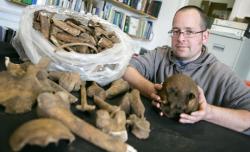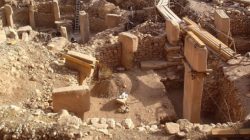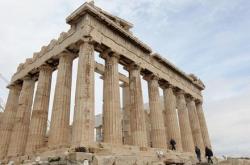INSTITUT SUPERIEUR D'ANTHROPOLOGIE
INSTITUTE OF ANTHROPOLOGY
ONLINE COURSES / COURS A DISTANCE
INSCRIPTION 2012 / Session II : Avril 2012
REGISTRATION 2012 / Term II : April 2012
FRANCE –  Marseille - Quelques vestiges du troisième lazaret de Marseille, hôpital de quarantaine du XVIIe siècle construit entre 1663 et 1668, ont été mis au jour sur le chantier de NéoMed mené par la société Bouygues Immobilier, dans le périmètre d'Euroméditérannée (2e). « D'après les documents historiques, nous savions que le lazaret se trouvait par ici mais les vestiges n'ont jamais été retrouvés jusqu'à maintenant, explique Valérie Diez, la directrice de Chronoterre archéologie, qui gère les fouilles sur le chantier. Deux sondages ont été effectués à 6 et 8 mètres : ils ont permis de constater des niveaux de murs et de sols ». Depuis cette découverte, les archéologues s'activent pour construire un plan de lieux. « Nous avons atteint le deuxième niveau de sol, nous sommes en train de vérifier son état pour faire une typographie », précise Philippe, archéologue. Le sol actuellement mis à jour est celui du hangar du lazaret, en service jusqu'en 1850. Les cargaisons des bateaux soupçonnés d'apporter des maladies étaient stockées dans ce hangar. Il accueillit le navire « Le grand Saint-Antoine », à l'origine de la grande épidémie de peste de 1720, ayant décimé la moitié de la population phocéenne. Deux autres lazarets ont été construits. Un premier aurait existé dans l'anse de l'Ours au nord de la ville, géré par la confrérie de gens de la mer, également en charge les léproseries. Le second a été édifié en 1557 au sud de la ville.
Marseille - Quelques vestiges du troisième lazaret de Marseille, hôpital de quarantaine du XVIIe siècle construit entre 1663 et 1668, ont été mis au jour sur le chantier de NéoMed mené par la société Bouygues Immobilier, dans le périmètre d'Euroméditérannée (2e). « D'après les documents historiques, nous savions que le lazaret se trouvait par ici mais les vestiges n'ont jamais été retrouvés jusqu'à maintenant, explique Valérie Diez, la directrice de Chronoterre archéologie, qui gère les fouilles sur le chantier. Deux sondages ont été effectués à 6 et 8 mètres : ils ont permis de constater des niveaux de murs et de sols ». Depuis cette découverte, les archéologues s'activent pour construire un plan de lieux. « Nous avons atteint le deuxième niveau de sol, nous sommes en train de vérifier son état pour faire une typographie », précise Philippe, archéologue. Le sol actuellement mis à jour est celui du hangar du lazaret, en service jusqu'en 1850. Les cargaisons des bateaux soupçonnés d'apporter des maladies étaient stockées dans ce hangar. Il accueillit le navire « Le grand Saint-Antoine », à l'origine de la grande épidémie de peste de 1720, ayant décimé la moitié de la population phocéenne. Deux autres lazarets ont été construits. Un premier aurait existé dans l'anse de l'Ours au nord de la ville, géré par la confrérie de gens de la mer, également en charge les léproseries. Le second a été édifié en 1557 au sud de la ville.
http://www.20minutes.fr/article/890181/vestiges-lazaret-phoceen-mis-jour
ROYAUME UNI –  Norton - Archaeologists have got to the bottom of how a major hoard of human bones came to be discovered in the garden of a semi-detached house in Norton. Experts at Tees Archaeology have been examining the find since it was unearthed five years ago. And they have now confirmed the bones found in the quiet cul-de-sac are of Anglo-Saxon origin - and represent a cemetery containing at least 22 men, women and children from around 780 AD. The bones were originally discovered in 2007 by workmen building a conservatory at the 1950s-built house. A single jawbone was first to be unearthed, but more bones including femurs and skulls followed, both from the back garden and under the front porch which was also being rebuilt.
Norton - Archaeologists have got to the bottom of how a major hoard of human bones came to be discovered in the garden of a semi-detached house in Norton. Experts at Tees Archaeology have been examining the find since it was unearthed five years ago. And they have now confirmed the bones found in the quiet cul-de-sac are of Anglo-Saxon origin - and represent a cemetery containing at least 22 men, women and children from around 780 AD. The bones were originally discovered in 2007 by workmen building a conservatory at the 1950s-built house. A single jawbone was first to be unearthed, but more bones including femurs and skulls followed, both from the back garden and under the front porch which was also being rebuilt.
http://www.gazettelive.co.uk/news/teesside-news/2012/03/02/experts-reveal-answers-over-norton-bones-84229-30444640/
TURQIE –  - Gobekli Tepe - Atlantic Productions has been commissioned by National Geographic Channel to produce Cradle of the Gods, a 60-minute special investigating the temple site of Gobekli Tepe in Turkey. Cradle of the Gods follows American archaeologist Dr Jeff Rose on his journey to Turkey with renowned German archaeologist Professor Klaus Schmidt, to the ancient ruins of the 12,000 year old temple at Gobekli Tepe. Schmidt believes this is the first human-built holy place, and that its mysterious stones suggest a novel theory of civilisation. Scholars have long believed that it was the advent of a farming society which brought early humans together, propelling us from the Stone Age to the present day. Dr Jeff Rose will demonstrate that it was religion which came first: the co-ordinated effort to build the temple laid the groundwork for the development of complex societies.
- Gobekli Tepe - Atlantic Productions has been commissioned by National Geographic Channel to produce Cradle of the Gods, a 60-minute special investigating the temple site of Gobekli Tepe in Turkey. Cradle of the Gods follows American archaeologist Dr Jeff Rose on his journey to Turkey with renowned German archaeologist Professor Klaus Schmidt, to the ancient ruins of the 12,000 year old temple at Gobekli Tepe. Schmidt believes this is the first human-built holy place, and that its mysterious stones suggest a novel theory of civilisation. Scholars have long believed that it was the advent of a farming society which brought early humans together, propelling us from the Stone Age to the present day. Dr Jeff Rose will demonstrate that it was religion which came first: the co-ordinated effort to build the temple laid the groundwork for the development of complex societies.
http://www.televisual.com/news-detail/Atlantic-to-make-Turkish-archaeology-special-for-Nat-Geo_nid-1298.html
FRANCE – Longwy - Un coup de pelle mécanique a mis à jour tout un pan de l’histoire de Longwy. Pas étonnant, les immeubles HLM de l’avenue du 8 -Mai-1945 ont été construits en 1970 sur des vestiges de l’époque des remparts Vauban. Ce sont des fouilles entreprises par l’Inrap Grand Est-Nord (Institut national en recherche archéologique préventive), à la demande de la Ville de Longwy, qui ont permis de découvrir un mur de 20 m de long, formant une contrescarpe des remparts Vauban datant du XVII e siècle.
http://www.republicain-lorrain.fr/meurthe-et-moselle/2012/03/02/nouveaux-vestiges-vauban
GRECE –  - Lack of funding in crisis-hit Greece has stymied archaeological research and leads experts to rebury valuable discoveries to better protect them. "Mother Earth is the best protector of our antiquities," Michalis Tiverios, a professor of archaeology at Thessaloniki's Aristotelio University, told Ta Nea daily on the sidelines of an annual archaeological congress in the city. Tiverios recently persuaded the culture ministry to rebury a previously-unknown Early Christian basilica, found two years ago during work on Thessaloniki's new underground railway. "We were unable to carry out excavations in 2011," Pavlos Chrysostomou, a site excavation supervisor in northern Greece, told the newspaper. "This summer, we found more than 10 pits at the site that were not ours. It was probably 'colleagues' of ours, grave robbers," he said. Chrysostomou oversees an important excavation at a 20-hectare (50-acre) necropolis in Pella, the capital of the ancient Macedonian kingdom which reached its full expansion in the 4th century BC with the conquests of Alexander the Great. Among the area's choice finds are gold funerary masks that adorned the graves of Macedonian nobles and prominent warriors. Masks of this type, among a hoard of other golden grave offerings from the 6th century BC, were found in the possession of smugglers in October.
- Lack of funding in crisis-hit Greece has stymied archaeological research and leads experts to rebury valuable discoveries to better protect them. "Mother Earth is the best protector of our antiquities," Michalis Tiverios, a professor of archaeology at Thessaloniki's Aristotelio University, told Ta Nea daily on the sidelines of an annual archaeological congress in the city. Tiverios recently persuaded the culture ministry to rebury a previously-unknown Early Christian basilica, found two years ago during work on Thessaloniki's new underground railway. "We were unable to carry out excavations in 2011," Pavlos Chrysostomou, a site excavation supervisor in northern Greece, told the newspaper. "This summer, we found more than 10 pits at the site that were not ours. It was probably 'colleagues' of ours, grave robbers," he said. Chrysostomou oversees an important excavation at a 20-hectare (50-acre) necropolis in Pella, the capital of the ancient Macedonian kingdom which reached its full expansion in the 4th century BC with the conquests of Alexander the Great. Among the area's choice finds are gold funerary masks that adorned the graves of Macedonian nobles and prominent warriors. Masks of this type, among a hoard of other golden grave offerings from the 6th century BC, were found in the possession of smugglers in October.
http://www.montrealgazette.com/news/Greek+antiquities+reburied+lack+funds+report/6240554/story.html